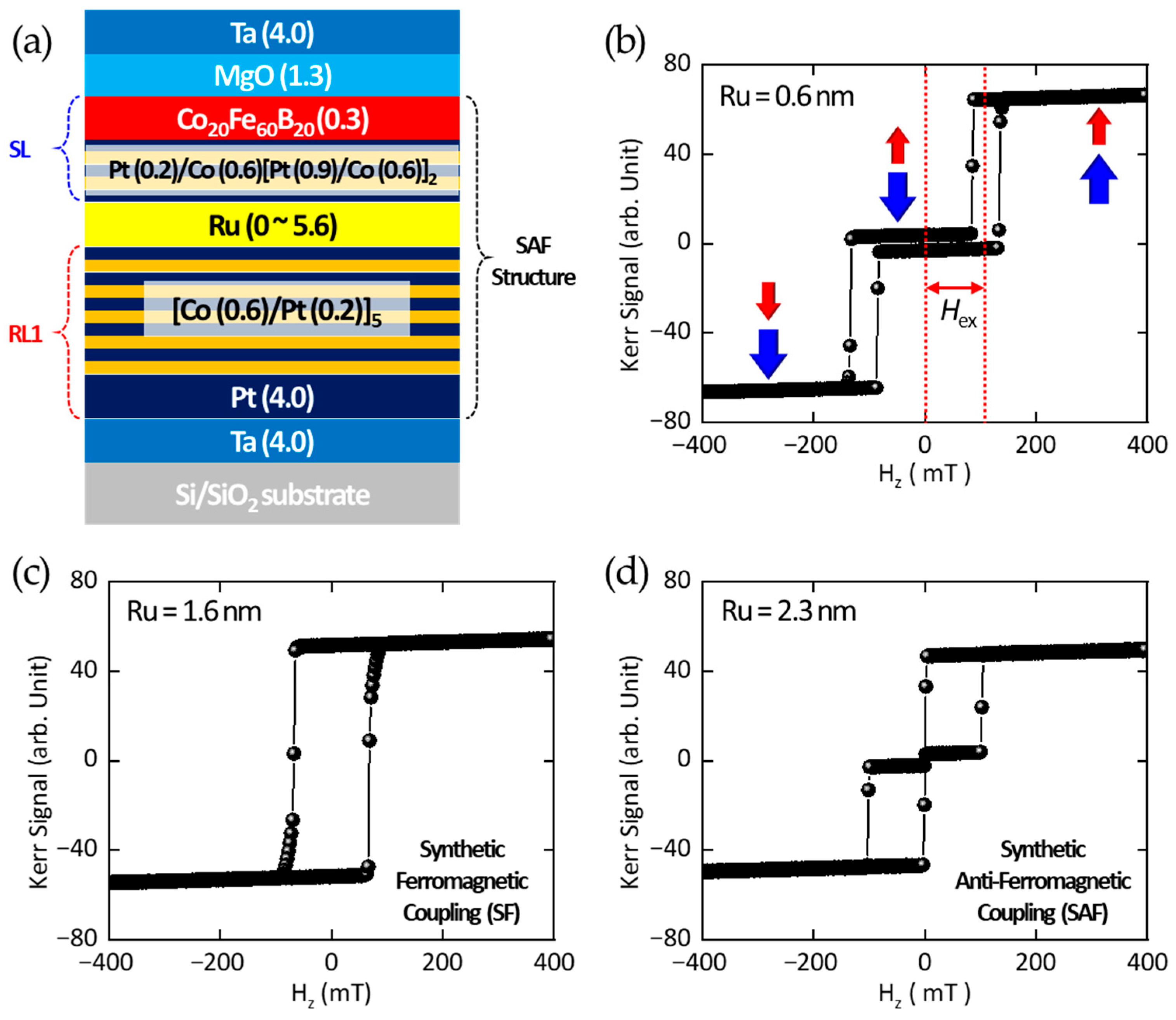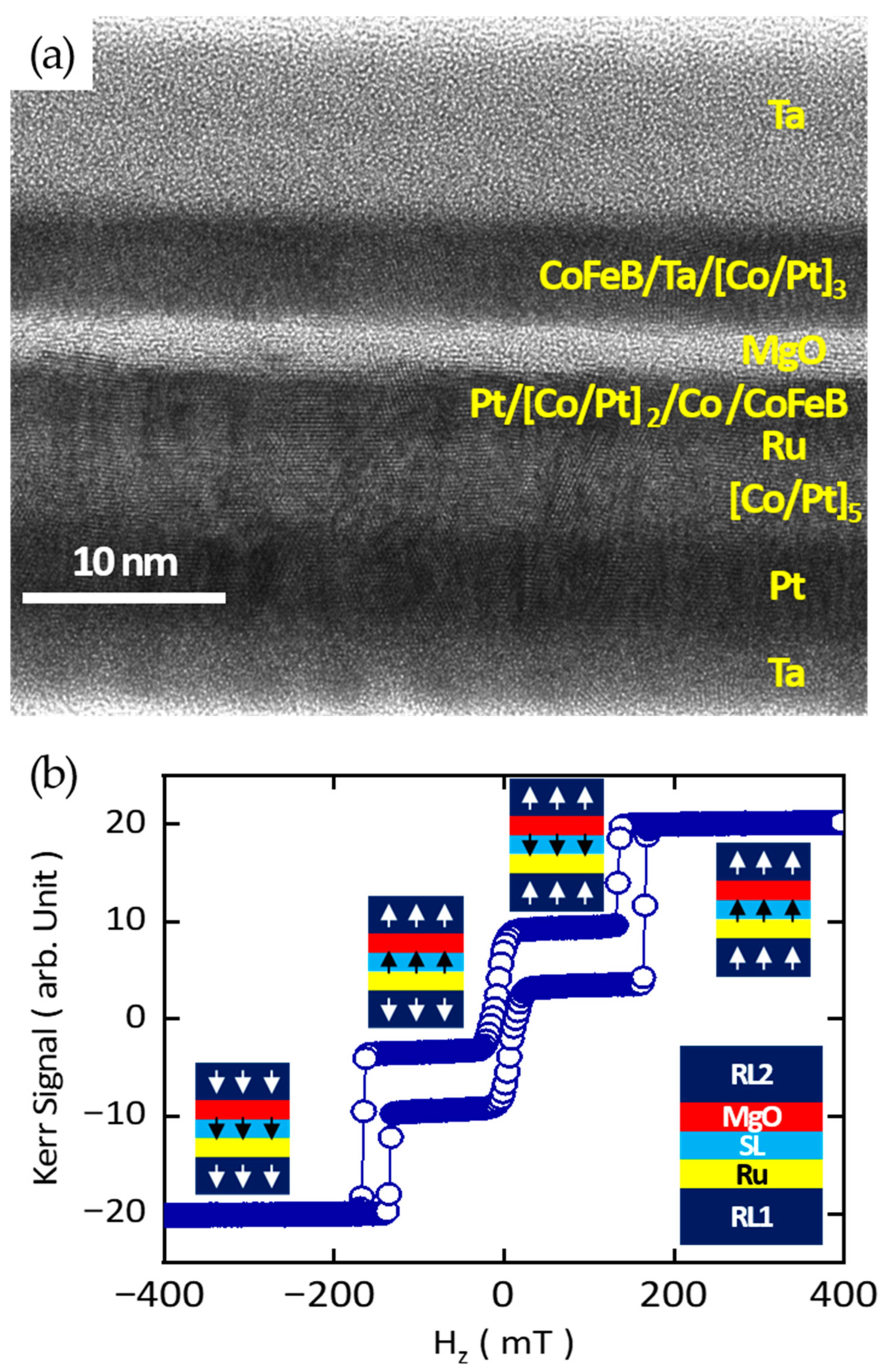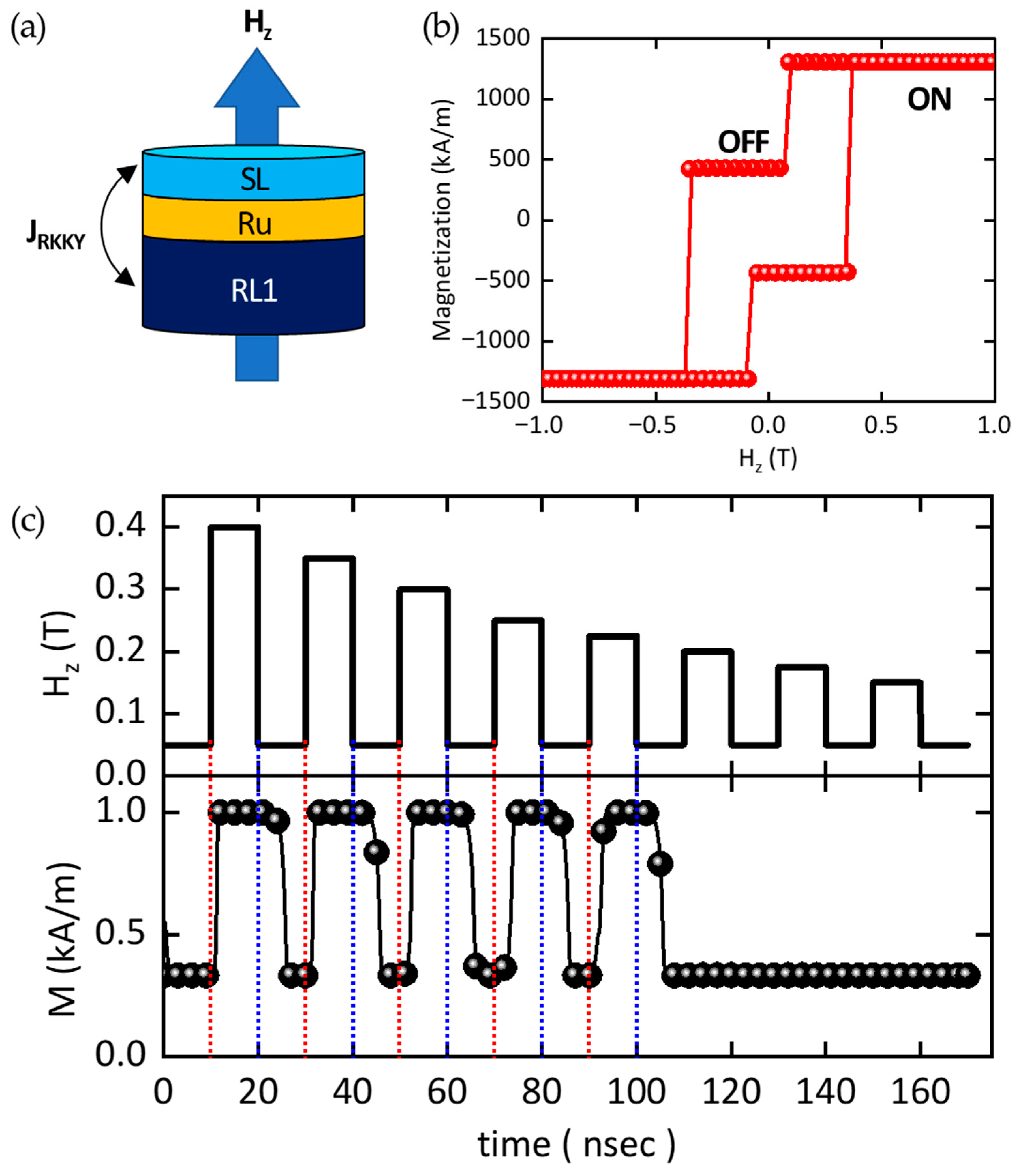Introduction of RKKY-pMTJ-Based Ultrafast Magnetic Sensor Architecture and Magnetic Multilayer Optimization
Abstract
1. Introduction
2. Sensor Architecture and Working Principle
3. Experimental Methods
4. Results and Discussion
4.1. Magnetic Multilayer Structure for RKKY-pMTJ-Based TMR Sensor
4.2. Ru Thickness-Dependent RKKY Interaction and Periodicity Measurements
4.3. Structural Analysis of RKKY-pMTJ-Based Ultrafast TMR Sensor via Transmission Electron Microscopy
4.4. Micromagnetic Simulations for Ultrafast TMR Sensor Response: Magnetic Field-Driven SL Reversal and Recovery Time Calculations
5. Conclusions
Author Contributions
Funding
Institutional Review Board Statement
Informed Consent Statement
Data Availability Statement
Acknowledgments
Conflicts of Interest
References
- Vaheeda, J.T.; George, B. TMR Sensor-Based Detection of EVs in Semi-Dynamic Traffic for Optimal Charging. IEEE Trans. Intell. Transp. Syst. 2022, 23, 13721–13730. [Google Scholar] [CrossRef]
- Liu, X.; Liu, C.; Han, W.; Pong, P.W.T. Design and Implementation of a Multi-Purpose TMR Sensor Matrix for Wireless Electric Vehicle Charging. IEEE Sens. J. 2019, 19, 1683–1692. [Google Scholar] [CrossRef]
- Liu, X.; Liu, C.; Pong, P.W.T. TMR-Sensor-Array-Based Misalignment-Tolerant Wireless Charging Technique for Roadway Electric Vehicles. IEEE Trans. Magn. 2019, 55, 4003107. [Google Scholar] [CrossRef]
- Nandapurkar, K.B.; Sreekantan, A.C.; Dutta, P.K. Performance Investigation of a Simplified TMR-Based Rotary Position Sensing System. IEEE Trans. Inst. Meas. 2021, 70, 9505408. [Google Scholar]
- Ranjan, R.; Shekhar, A.; Manda, S. Development of a Tunneling Magneto-Resistance Sensor Based Orientation Detection System for Robotic Manipulator. In Proceedings of the 2025 6th International Conference on Recent Advances in Information Technology (RAIT), Dhanbad, India, 6–8 March 2025. [Google Scholar]
- Khan, M.A.; Sun, J.; Li, B.; Przybysz, A.; Kosel, J. Magnetic sensors—A review and recent technologies. Eng. Res. Express 2021, 3, 022005. [Google Scholar]
- Wiśniowski, P.; Nawrocki, M.; Wrona, J.; Cardoso, S.; Freitas, P.P. Bias Voltage Dependence of Sensing Characteristics in Tunneling Magnetoresistance Sensors. Sensors 2021, 21, 2495. [Google Scholar] [CrossRef] [PubMed]
- Jin, Z.; Sam, M.A.I.M.N.; Oogane, M.; Ando, Y. Serial MTJ-Based TMR Sensors in Bridge Configuration for Detection of Fractured Steel Bar in Magnetic Flux Leakage Testing. Sensors 2021, 21, 668. [Google Scholar] [CrossRef]
- Ikegawa, S.; Mancoff, F.B.; Janesky, J.; Aggarwal, S. Magnetoresistive Random Access Memory: Present and Future. IEEE Trans. Electron. Devices 2020, 67, 1407–1419. [Google Scholar] [CrossRef]
- Ohno, H.; Endoh, T.; Hanyu, T.; Ando, Y.; Ikeda, S. Spin-transfer-torque magnetoresistive random access memory (STT-MRAM) technology. In Book Advances in Non-Volatile Memory and Storage Technology, 1st ed.; Nishi, Y., Ed.; Woodhead Publishing: Cambridge, UK, 2014; pp. 455–494. [Google Scholar]
- Cho, J.; Kim, N.-H.; Lee, S.; Kim, J.-S.; Lavrijsen, R.; Solignac, A.; Yin, Y.; Han, D.-S.; van Hoof, N.J.J.; Swagten, H.J.M.; et al. Thickness dependence of the interfacial Dzyaloshinskii–Moriya interaction in inversion symmetry broken systems. Nat. Commun. 2015, 6, 7635. [Google Scholar] [CrossRef]
- Jung, J.; Cho, J.; Choi, H.-C.; Lee, K.; You, C.-Y.; Choe, S.-B.; Kim, J.-S. Modulations of interfacial magnetic properties using structurally inverted magnetic tri-layer systems: Toward skyrmion formation. Appl. Phys. Lett. 2021, 118, 262408. [Google Scholar] [CrossRef]
- Cho, J.; Jung, J.; Kim, S.B.; Ju, W.R.; Kim, D.H.; Byun, M.; Kim, J.-S. The Stack Optimization of Magnetic Heterojunction Structures for Next-Generation Spintronic Logic Applications. Materials 2023, 16, 6418. [Google Scholar] [CrossRef]
- Cho, J.; Lee, C.-K.; Kim, J.; Kim, J.-S.; You, C.-Y. The sign of the interfacial Dzyaloshinskii–Moriya interaction in ultrathin amorphous and polycrystalline magnetic films. J. Phys. D Appl. Phys. 2022, 55, 435008. [Google Scholar] [CrossRef]
- Liu, Y.; Qiu, J.; Lim, Z.T.; Toh, S.L.; Zhu, Z.; Han, G.; Zhu, K. Strong perpendicular magnetic anisotropy in [Co/Pt]n ultrathin superlattices. Appl. Phys. Expr. 2017, 10, 013005. [Google Scholar] [CrossRef]
- Yakushiki, K.; Saruya, T.; Kubota, H.; Fukushima, A.; Nagahama, T.; Yuasa, S.; Ando, K. Ultrathin Co/Pt and Co/Pd superlattice films for MgO-based perpendicular magnetic tunnel junctions. Appl. Phys. Lett. 2010, 97, 232508. [Google Scholar] [CrossRef]
- Ikeda, S.; Miura, K.; Yamamoto, H.; Mizunuma, K.; Gan, H.D.; Endo, M.; Kanai, S.; Hayakawa, J.; Matsukura, F.; Ohno, H. A perpendicular-anisotropy CoFeB–MgO magnetic tunnel junction. Nat. Mater. 2010, 9, 721–724. [Google Scholar] [CrossRef]
- Yen, Y.-S.; Yang, C.-L.; Chang, Y.-L.; Lai, C.-H. Optimizing Perpendicular Magnetic Anisotropy in MgO/CoFeB Structures Through Ultrathin CoFeB-Enhanced Ta Capping Layers. ACS Omega 2025, 10, 18510–18516. [Google Scholar] [CrossRef]
- Li, Z.-P.; Li, S.; Zheng, Y.; Fang, J.; Chen, L.; Hong, L.; Wang, H. The study of origin of interfacial perpendicular magnetic anisotropy in ultra-thin CoFeB layer on the top of MgO based magnetic tunnel junction. Appl. Phys. Lett. 2016, 109, 182403. [Google Scholar] [CrossRef]
- Chiou, J.-Y.; Chang, H.W.; Chi, C.-C.; Hsiao, C.-H.; Ouyang, C. L10 FePt Films with Optimal (001) Texture on Amorphous SiO2/Si Substrates for High-Density Perpendicular Magnetic Recording Media. ACS Appl. Nano Mater. 2019, 2, 5663–5673. [Google Scholar] [CrossRef]
- Lee, H.-R.; Lee, K.; Cho, J.; Choi, Y.-H.; You, C.-Y.; Jung, M.-H.; Bonell, F.; Shiota, Y.; Miwa, S.; Suzuki, Y. Spin-orbit torque in a bulk perpendicular magnetic anisotropy Pd/FePd/MgO system. Sci. Rep. 2014, 4, 6548. [Google Scholar] [CrossRef]
- Nishioka, K.; Honjo, H.; Ikeda, S.; Watanabe, T.; Miura, S.; Inoue, H.; Tanigawa, T.; Noguchi, Y.; Yasuhira, M.; Sato, H.; et al. Novel Quad-Interface MTJ Technology and Its First Demonstration with High Thermal Stability Factor and Switching Efficiency for STT-MRAM Beyond 2X nm. IEEE Trans. Electron. Devices 2020, 67, 995–1000. [Google Scholar] [CrossRef]
- Liu, E.; Swerts, J.; Wu, Y.C.; Vaysset, A.; Couet, S.; Mertens, S.; Rao, S.; Kim, W.; Elshocht, S.V.; Boeck, J.D.; et al. Top-Pinned STT-MRAM Devices with High Thermal Stability Hybrid Free Layers for High-Density Memory Applications. IEEE Trans. Magn. 2018, 54, 3401805. [Google Scholar] [CrossRef]
- Huai, Y.; Gan, H.; Wang, Z.; Xu, P.; Hao, X.; Yen, B.K.; Malmhall, R.; Pakala, N.; Wang, C.; Zhang, Z.; et al. High performance perpendicular magnetic tunnel junction with Co/Ir interfacial anisotropy for embedded and standalone STT-MRAM applications. Appl. Phys. Lett. 2018, 112, 092402. [Google Scholar] [CrossRef]
- Gan, H.; Malmhall, R.; Wang, Z.; Yen, B.K.; Zhang, J.; Wang, X.; Zhou, Y.; Hao, X.; Jung, D.; Satoh, K.; et al. Perpendicular magnetic tunnel junction with thin CoFeB/Ta/Co/Pd/Co reference layer. Appl. Phys. Lett. 2014, 105, 192403. [Google Scholar] [CrossRef]
- Parkin, S.S.P.; More, N.; Roche, K.P. Oscillations in exchange coupling and magnetoresistance in metallic superlattice structures: Co/Ru, Co/Cr, and Fe/Cr. Phys. Rev. Lett. 1990, 64, 2304. [Google Scholar] [CrossRef]
- Bandiera, S.; Sousa, R.C.; Auffret, S.; Rodmacq, B.; Dieny, B. Enhancement of perpendicular magnetic anisotropy thanks to Pt insertions in synthetic antiferromagnets. Appl. Phys. Lett. 2012, 101, 072410. [Google Scholar] [CrossRef]
- Bruno, P. Theory of interlayer exchange interactions in magnetic multilayers. J. Phys. Condens. Matter 1999, 11, 9403. [Google Scholar] [CrossRef]
- Yafet, Y. Ruderman-Kittel-Kasuya-Yosida range function of a one-dimensional free-electron gas. Phys. Rev. B 1987, 36, 3948. [Google Scholar] [CrossRef] [PubMed]
- Stiles, M.D. Exchange coupling in magnetic heterostructures. Phys. Rev. B 1993, 48, 7238. [Google Scholar] [CrossRef] [PubMed]
- Saito, Y.; Ikeda, S.; Endoh, T. Synthetic antiferromagnetic layer based on Pt/Ru/Pt spacer layer with 1.05 nm interlayer exchange oscillation period for spin–orbit torque devices. Appl. Phys. Lett. 2021, 119, 142401. [Google Scholar] [CrossRef]
- Bloemen, P.J.H.; Vankesteren, H.W.; Swagten, H.J.M.; Dejonge, W.J.M. Oscillatory interlayer exchange coupling in Co/Ru multilayers and bilayers. Phys. Rev. B 1994, 50, 13505. [Google Scholar] [CrossRef]
- Folkerts, W. Calculated magnetic phase diagrams and magnetoresistance curves for an antiferromagnetically coupled multilayer system. J. Magn. Magn. Mater. 1991, 94, 302. [Google Scholar] [CrossRef]
- Vansteenkiste, A.; Leliaert, J.; Dvornik, M.; Helsen, M.; Garcia-Sanchez, P.; Waeyenberge, B.V. The design and verification of MuMax3. AIP Adv. 2014, 4, 107133. [Google Scholar] [CrossRef]





| Material Parameter (Unit) | Reference Layer 1 (RL1) | Storage Layer (SL) |
|---|---|---|
| Saturation Magnetization (Ms) (kA/m) | 1300 | 1313 |
| Perpendicular Magnetic Anisotropy Energy Density (Ku) (MJ/m3) | 1300 | 1300 |
| Exchange Stiffness (Aex) (pJ/m) | 15 | 15 |
| RKKY Exchange Coefficient (JRKKY) (mJ/m2) | −1.2 | |
| Sensor Type | Typical Functional Layer (nm) | Thickness Tolerance for Functional Layer (%) | Scaling Potential | Limitation/ Advantage |
|---|---|---|---|---|
| AMR [6] | 25 | ±10% (~±2.5 nm) | >1 µm | Signal weakens at nanoscale |
| GMR [6] | 2.0 (spacer layer) | ±5% (±0.1 nm) | ≈200 nm | Interface roughness sensitive |
| In-plane TMR [6] | 1.0 (MgO Barrier) | ±3% (±0.03 nm) | ≈100 nm | Barrier oxidation |
| Proposed RKKY-pMTJ | 0.6 (Ru layer) | ±17% (±0.1 nm) | <100 nm | IEC-based self-restoring, robust to scaling |
| Switching Time | Hz = 400 mT | 350 mT | 300 mT | 250 mT | 200 mT |
|---|---|---|---|---|---|
| tSAF→SF | 1.39 ns | 1.82 ns | 2.59 ns | 2.90 ns | 2.94 ns |
| tSF→SAF | 5.99 ns | 5.96 ns | 5.91 ns | 5.84 ns | 5.78 ns |
Disclaimer/Publisher’s Note: The statements, opinions and data contained in all publications are solely those of the individual author(s) and contributor(s) and not of MDPI and/or the editor(s). MDPI and/or the editor(s) disclaim responsibility for any injury to people or property resulting from any ideas, methods, instructions or products referred to in the content. |
© 2025 by the authors. Licensee MDPI, Basel, Switzerland. This article is an open access article distributed under the terms and conditions of the Creative Commons Attribution (CC BY) license (https://creativecommons.org/licenses/by/4.0/).
Share and Cite
Cho, J.; Kim, J.-S. Introduction of RKKY-pMTJ-Based Ultrafast Magnetic Sensor Architecture and Magnetic Multilayer Optimization. Sensors 2025, 25, 6793. https://doi.org/10.3390/s25216793
Cho J, Kim J-S. Introduction of RKKY-pMTJ-Based Ultrafast Magnetic Sensor Architecture and Magnetic Multilayer Optimization. Sensors. 2025; 25(21):6793. https://doi.org/10.3390/s25216793
Chicago/Turabian StyleCho, Jaehun, and June-Seo Kim. 2025. "Introduction of RKKY-pMTJ-Based Ultrafast Magnetic Sensor Architecture and Magnetic Multilayer Optimization" Sensors 25, no. 21: 6793. https://doi.org/10.3390/s25216793
APA StyleCho, J., & Kim, J.-S. (2025). Introduction of RKKY-pMTJ-Based Ultrafast Magnetic Sensor Architecture and Magnetic Multilayer Optimization. Sensors, 25(21), 6793. https://doi.org/10.3390/s25216793






